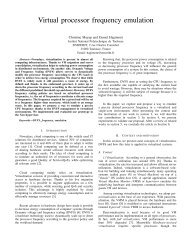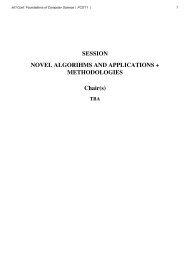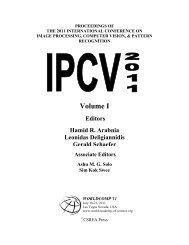6 Int'l Conf. Foundations of Computer Science | FCS'12 | properties mentioned. In this case it calls the procedure lookF orV MT LsUsingIt, lookF orV MT LsUsingIt(s, h, theNumbersF or- Labels, soF arF orV ertices); To complete this procedure, we need two recursive calls, one of which attempts to use the current element of theNumbersF orLabels to make a desired set of vertex labels, and the other of which attempts to make a desired set of vertex labels without the current element. The first corresponds to using the current element of theNumbersF orLabels, theNumbersF orLabels[currentIndexOfChoices]. We recurse with that together with the information in the parameter soF arF orV ertices for the last argument. (We also have to use the appropriate updated values for the sixth and seventh arguments corresponding to size and sum and the eighth argument corresponding to the element of theNumbersF orLabels that should be considered next.) The second recursive call corresponds to us not selecting the current element of theNumbersF orLabels. For this recursive call, no new information is being added to the information in soF arF orV ertices. The eighth argument corresponding to the element of theNumbersF orLabels needs to be updated. 3. procedure lookF orV MT LsUsingIt(int s, int h, int[ ] theNumbersF orLabels, int[ ] theNumbersF orV ertices); Since we have a specific subset of all possible labels to use for the vertices, the remaining labels must be for the edges. Store these in int[ ] theNumbersF orEdges. Next, call the recursive procedure generateV MT Ls, with a call such as generateV MT Ls(theNumbersF orV ertices, the- NumbersF orEdges, h, s, {false, . . . , false}, null, −1); This procedure will attempt to generate VMTLs using these. 4. procedure generateV MT Ls(int[ ] theNumbersF or- V ertices, int[ ] remainingNumbersF orEdges, int h, int s, boolean[ ] usedV ertexIndex, int[ ][ ] ivml- Indices, int[ ] commonDifferences, int currentIndex- OfIV ML); This procedure tries to find VMTLs by labeling one component at a time. The first parameter, theNumbersF orV erices, gives the set of numbers that is to be used for labeling all the vertices. The parameters ivmlIndices and commonDifferences keep track of an IVML that we are trying to grow. The parameter ivmlIndices keeps track of triples of indices in theNumbersF orV ertices. One triple corresponds to one component, so if we ever get s triples we have our vertex labels. From such a triple, the corre- sponding three elements in theNumbersF orV ertices are currently being used as the vertex labels for one component. The common difference for that component can be found in the appropriate element in commonDifferences. From these pieces of information, we have the edge labels for that component. As we grow an IVML, some labels are used for edges. The second parameter keeps track of the edge labels that have not as yet been used. The first parameter, theNumbersF orV ertices, is the set of all of the labels for the vertices, and the usedV ertexIndex parameter keeps track of those that have been used so far. This procedure has a base case corresponding to finding a solution. If the parameter ivmlIndices has length s, then it corresponds to a VMTL, in which case that information is outputted, and the procedure returns. This procedure has a loop to continually look for all possible labelings of one component that could be used to augment the information in ivmlIndices and commonDifferences, to give a bigger IVML. The corresponding edge labels need to be available. (Recall that Lemma 2.2 part (i) gives us these values.) If they are, then we can recurse on this bigger IVML with all parameters except the first updated. When the loop is finished, this procedure returns. It is important to note that we have several filters in place in the loop above so that (a) we ignore labels of a component that won’t lead to a solution, and (b) so that we ignore labels of a component that won’t lead to a specific type of solution that we are after. Filters of type (a) are used for the purposes of making the algorithm faster. If we exclude filters of the type (b), then our algorithm will find all possible VMTLs for the specified values of s and h. If we include filter of type (b), we will only be looking for VMTLs with certain properties. We often use filters of both types in order to find certain solutions quickly. We will discuss the use of filters further shortly. Finally, we can generate other VMTLs from the output of generateV MT Ls using Lemma 2.3. This can be done by hand (or by another procedure). Algorithm 3.1 uses several tools so that it is efficient: (i) In the main, our loop considered roughly half of the feasible magic constants. Duality can be used for the others. Parallelism can also be used here. (ii) In the second procedure, whichLabelsAreF orV ertices, we used the results of Proposition 3.1 to restrict the possibilities for sets of numbers to be considered as vertex labels. (iii) In generateV MT Ls( ), when we looked for a triple to label the vertices of one component, we eliminated possibilities that did not satisfy Lemma 2.2 part (v).
Int'l Conf. Foundations of Computer Science | FCS'12 | 7 (iv) We were able to focus on labeling the vertices because of Lemma 2.2 part (iv). We just needed to make sure that the corresponding edge labels were available when we had labels that we liked for the vertices of a component. Sometimes, we are interested in finding only labellings in which some components have specific common differences. In this case, Lemma 2.2 part (iv) helps us reduce the number of triples that we need to consider as possible labels for the vertices of a component. In generateV MT Ls( ), when we looked for a triple to label the vertices of one component, we eliminated possibilities that did not satisfy Lemma 2.2 part (iv) in this situation. (v) Use Lemma 2.3 to generate many other VMTLs. In Algorithm 3.1, we use several filters. In generateV MT Ls, when we have an IVML with some components labeled, we try to extend it to VMTLs by labeling an additional component (recursively). Sometimes, a potential labeling of a “next” component can be removed from consideration (“filtered”) because we can tell that it will never lead to a VMTL, or because it will not lead to a specific type of VMTL that we are interested in finding. If we are given the common differences of any of the components as input, then some triples can be immediately eliminated from consideration as possible vertex labels for a component because of Lemma 2.2 part (iv). If restrictions are given, such as the common difference restiction of Problem 2.1, we might be able to eliminate triples here or at some other point in the algorithm. 4. VMTLs for 7C3, 9C3, and 11C3. Using Algorithm 3.1, we now answer Problem 1.1 in the affirmative for 7C3, 9C3, and 11C3 for each of their respective feasible magic constants. In order to do so, we answer Problem 2.1 in the affirmative for certain values of h and s0 for 7C3, 9C3, and 11C3. Then, we use Lemma 2.3. Theorem 4.1: There exists VMTLs for all of the feasible values of 7C3. Proof: Consider the VMTL with components labeled [1, 37, 15, 22, 16, 36], [2, 39, 12, 23, 18, 33], [3, 42, 8, 24, 21, 29], [4, 40, 9, 25, 19, 30], [5, 38, 10, 26, 17, 31], [6, 41, 20, 13, 34, 27], and [7, 35, 11, 28, 14, 32]. This VMTL has a magic constant of 74. The first three components have common differences of 3s. Therefore, by using Lemma 2.3 three times, we have VMTLs of 7C3 with magic constants 71, 68, 65. By duality, there exist VMTLs with magic constants of 55, 58, 61 and 64. Next, consider the VMTL with components labeled [1, 37, 14, 22, 16, 35], [2, 38, 12, 23, 17, 33], [3, 42, 20, 11, 34, 28], [4, 40, 15, 18, 26, 29], [5, 36, 6, 31, 10, 32], [7, 39, 9, 25, 21, 27], and [8, 41, 13, 19, 30, 24]. This VMTL has a magic constant of 73. The first two components have common differences of 3s. By using Lemma 2.3 twice, there exist VMTLs of 7C3 with magic constants 70 and 67. By duality, there exist VMTLs with magic constants of 56, 59 and 62. Finally, in [27] it was shown that there exist VMTLs of 7C3 with magic constants with values 75, 72, 69, 66, 63, 60, 57, 54. Theorem 4.2: There exists VMTLs for all of the feasible values of 9C3. Proof: Consider the VMTL with components labeled [1, 46, 18, 28, 19, 45], [2, 52, 11, 29, 25, 38], [3, 49, 13, 30, 22, 40], [4, 54, 12, 26, 32, 34], [5, 44, 9, 39, 10, 43], [6, 53, 16, 23, 36, 33], [7, 50, 27, 15, 42, 35], [8, 47, 31, 14, 41, 37], and [17, 51, 21, 20, 48, 24]. This VMTL has a magic constant of 92. The first three components have common differences of 3s. Therefore, by using Lemma 2.3 three times, we have VMTLs of 9C3 with magic constants 89, 86, and 83. By duality, there exist VMTLs with magic constants of 73, 76, 79, and 82. Next, consider the VMTL with components labeled [1, 47, 19, 28, 20, 46], [2, 50, 15, 29, 23, 42], [3, 51, 13, 30, 24, 40], [4, 49, 9, 36, 17, 41], [5, 52, 16, 26, 31, 37], [6, 45, 10, 39, 12, 43], [7, 53, 14, 27, 33, 34], [8, 54, 22, 18, 44, 32], and [11, 48, 25, 21, 38, 35]. This VMTL has a magic constant of 94. The first three components have common differences of 3s. By using Lemma 2.3 thrice, there exist VMTLs of 9C3 with magic constants of 91, 88 and 85. By duality, there exist VMTLs with magic constants of 71, 74, 77, and 80. Next, consider the VMTL with components labeled [1, 50, 17, 28, 23, 44], [2, 47, 19, 29, 20, 46], [3, 51, 14, 30, 24, 41], [4, 54, 16, 25, 33, 37], [5, 48, 12, 35, 18, 42], [6, 53, 10, 32, 27, 36], [7, 45, 11, 39, 13, 43], [8, 49, 15, 31, 26, 38], and [9, 52, 22, 21, 40, 34]. This VMTL has a magic constant of 95. By duality, there exists a VMTL with a magic constant of 70. Finally, in [27] it was shown that there exist VMTLs of 9C3 with magic constants with values 96, 93, 90, 87, 84, 81, 78, 75, 72 and 69. Theorem 4.3: There exists VMTLs for all of the feasible values of 11C3.
- Page 1 and 2: Int'l Conf. Foundations of Computer
- Page 3 and 4: Int'l Conf. Foundations of Computer
- Page 5: Int'l Conf. Foundations of Computer
- Page 9 and 10: Int'l Conf. Foundations of Computer
- Page 11 and 12: Int'l Conf. Foundations of Computer
- Page 13 and 14: Int'l Conf. Foundations of Computer
- Page 15 and 16: Int'l Conf. Foundations of Computer
- Page 17 and 18: Int'l Conf. Foundations of Computer
- Page 19 and 20: Int'l Conf. Foundations of Computer
- Page 21 and 22: Int'l Conf. Foundations of Computer
- Page 23 and 24: Int'l Conf. Foundations of Computer
- Page 25 and 26: Int'l Conf. Foundations of Computer
- Page 27 and 28: Int'l Conf. Foundations of Computer
- Page 29 and 30: Int'l Conf. Foundations of Computer
- Page 31 and 32: Int'l Conf. Foundations of Computer
- Page 33 and 34: Int'l Conf. Foundations of Computer
- Page 35 and 36: Int'l Conf. Foundations of Computer
- Page 37 and 38: Int'l Conf. Foundations of Computer
- Page 39 and 40: Int'l Conf. Foundations of Computer
- Page 41 and 42: Int'l Conf. Foundations of Computer
- Page 43 and 44: Int'l Conf. Foundations of Computer
- Page 45 and 46: Int'l Conf. Foundations of Computer
- Page 47 and 48: Int'l Conf. Foundations of Computer
- Page 49 and 50: Int'l Conf. Foundations of Computer
- Page 51 and 52: Int'l Conf. Foundations of Computer
- Page 53 and 54: Int'l Conf. Foundations of Computer
- Page 55 and 56: Int'l Conf. Foundations of Computer
- Page 57 and 58:
Int'l Conf. Foundations of Computer
- Page 59 and 60:
Int'l Conf. Foundations of Computer
- Page 61 and 62:
Int'l Conf. Foundations of Computer
- Page 63 and 64:
Int'l Conf. Foundations of Computer
- Page 65 and 66:
Int'l Conf. Foundations of Computer
- Page 67 and 68:
Int'l Conf. Foundations of Computer
- Page 69 and 70:
Int'l Conf. Foundations of Computer
- Page 71 and 72:
Int'l Conf. Foundations of Computer
- Page 73 and 74:
Int'l Conf. Foundations of Computer
- Page 75 and 76:
Int'l Conf. Foundations of Computer
- Page 77 and 78:
Int'l Conf. Foundations of Computer
- Page 79 and 80:
Int'l Conf. Foundations of Computer
- Page 81 and 82:
Int'l Conf. Foundations of Computer
- Page 83 and 84:
Int'l Conf. Foundations of Computer
- Page 85 and 86:
Int'l Conf. Foundations of Computer
- Page 87 and 88:
Int'l Conf. Foundations of Computer
- Page 89 and 90:
Int'l Conf. Foundations of Computer
- Page 91 and 92:
Int'l Conf. Foundations of Computer
- Page 93 and 94:
Int'l Conf. Foundations of Computer
- Page 95 and 96:
Int'l Conf. Foundations of Computer
- Page 97 and 98:
Int'l Conf. Foundations of Computer
- Page 99 and 100:
Int'l Conf. Foundations of Computer
- Page 101 and 102:
Int'l Conf. Foundations of Computer
- Page 103 and 104:
Int'l Conf. Foundations of Computer
- Page 105 and 106:
Int'l Conf. Foundations of Computer
- Page 107 and 108:
Int'l Conf. Foundations of Computer
- Page 109 and 110:
Int'l Conf. Foundations of Computer
- Page 111 and 112:
Int'l Conf. Foundations of Computer
- Page 113 and 114:
Int'l Conf. Foundations of Computer
- Page 115 and 116:
Int'l Conf. Foundations of Computer
- Page 117 and 118:
Int'l Conf. Foundations of Computer
- Page 119 and 120:
Int'l Conf. Foundations of Computer
- Page 121 and 122:
Int'l Conf. Foundations of Computer
- Page 123 and 124:
Int'l Conf. Foundations of Computer
- Page 125 and 126:
Int'l Conf. Foundations of Computer
- Page 127 and 128:
Int'l Conf. Foundations of Computer
- Page 129 and 130:
Int'l Conf. Foundations of Computer
- Page 131 and 132:
Int'l Conf. Foundations of Computer
- Page 133 and 134:
Int'l Conf. Foundations of Computer
- Page 135 and 136:
Int'l Conf. Foundations of Computer
- Page 137 and 138:
Int'l Conf. Foundations of Computer
- Page 139 and 140:
Int'l Conf. Foundations of Computer
- Page 141 and 142:
Int'l Conf. Foundations of Computer
- Page 143 and 144:
Int'l Conf. Foundations of Computer
- Page 145 and 146:
Int'l Conf. Foundations of Computer
- Page 147 and 148:
Int'l Conf. Foundations of Computer
- Page 149 and 150:
Int'l Conf. Foundations of Computer
- Page 151 and 152:
Int'l Conf. Foundations of Computer
- Page 153 and 154:
Int'l Conf. Foundations of Computer
- Page 155 and 156:
Int'l Conf. Foundations of Computer
- Page 157 and 158:
Int'l Conf. Foundations of Computer
- Page 159 and 160:
Int'l Conf. Foundations of Computer
- Page 161 and 162:
Int'l Conf. Foundations of Computer
- Page 163 and 164:
Int'l Conf. Foundations of Computer
- Page 165 and 166:
Int'l Conf. Foundations of Computer
- Page 167 and 168:
Int'l Conf. Foundations of Computer
- Page 169 and 170:
Int'l Conf. Foundations of Computer
- Page 171 and 172:
Int'l Conf. Foundations of Computer
- Page 173 and 174:
Int'l Conf. Foundations of Computer
- Page 175 and 176:
Int'l Conf. Foundations of Computer
- Page 177 and 178:
Int'l Conf. Foundations of Computer
- Page 179 and 180:
Int'l Conf. Foundations of Computer
- Page 181 and 182:
Int'l Conf. Foundations of Computer
- Page 183 and 184:
Int'l Conf. Foundations of Computer
- Page 185 and 186:
Int'l Conf. Foundations of Computer
- Page 187 and 188:
Int'l Conf. Foundations of Computer
- Page 189 and 190:
Int'l Conf. Foundations of Computer
- Page 191 and 192:
Int'l Conf. Foundations of Computer
- Page 193 and 194:
Int'l Conf. Foundations of Computer
- Page 195 and 196:
Int'l Conf. Foundations of Computer
- Page 197 and 198:
Int'l Conf. Foundations of Computer
- Page 199 and 200:
Int'l Conf. Foundations of Computer
- Page 201 and 202:
Int'l Conf. Foundations of Computer
- Page 203 and 204:
Int'l Conf. Foundations of Computer
- Page 205 and 206:
Int'l Conf. Foundations of Computer
- Page 207 and 208:
Int'l Conf. Foundations of Computer
- Page 209 and 210:
Int'l Conf. Foundations of Computer
- Page 211 and 212:
Int'l Conf. Foundations of Computer
- Page 213 and 214:
Int'l Conf. Foundations of Computer









